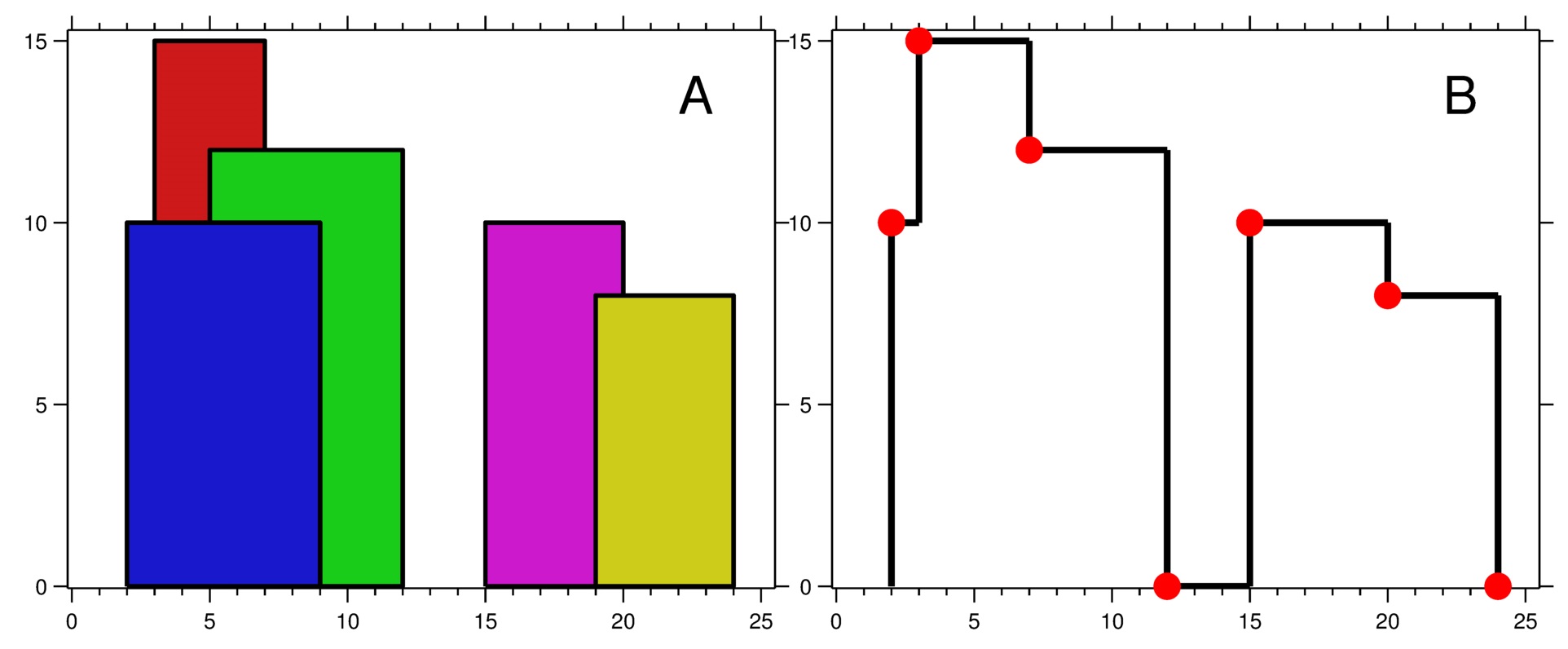城市的 天际线 是从远处观看该城市中所有建筑物形成的轮廓的外部轮廓。给你所有建筑物的位置和高度,请返回 由这些建筑物形成的 天际线 。
每个建筑物的几何信息由数组 buildings 表示,其中三元组 buildings[i] = [lefti, righti, heighti] 表示:
lefti是第i座建筑物左边缘的x坐标。righti是第i座建筑物右边缘的x坐标。heighti是第i座建筑物的高度。
你可以假设所有的建筑都是完美的长方形,在高度为 0 的绝对平坦的表面上。
天际线 应该表示为由 “关键点” 组成的列表,格式 [[x1,y1],[x2,y2],...] ,并按 x 坐标 进行 排序 。关键点是水平线段的左端点。列表中最后一个点是最右侧建筑物的终点,y 坐标始终为 0 ,仅用于标记天际线的终点。此外,任何两个相邻建筑物之间的地面都应被视为天际线轮廓的一部分。
注意:输出天际线中不得有连续的相同高度的水平线。例如 [...[2 3], [4 5], [7 5], [11 5], [12 7]...] 是不正确的答案;三条高度为 5 的线应该在最终输出中合并为一个:[...[2 3], [4 5], [12 7], ...]
示例 1:

输入:buildings = [[2,9,10],[3,7,15],[5,12,12],[15,20,10],[19,24,8]]
输出:[[2,10],[3,15],[7,12],[12,0],[15,10],[20,8],[24,0]]
解释:
图 A 显示输入的所有建筑物的位置和高度,
图 B 显示由这些建筑物形成的天际线。图 B 中的红点表示输出列表中的关键点。示例 2:
输入:buildings = [[0,2,3],[2,5,3]]
输出:[[0,3],[5,0]]提示:
1 <= buildings.length <= 1040 <= lefti < righti <= 231 - 11 <= heighti <= 231 - 1buildings按lefti非递减排序
class Solution {
public List<List<Integer>> getSkyline(int[][] buildings) {
PriorityQueue<int[]> pq = new PriorityQueue<int[]>((a, b) -> b[1] - a[1]);
List<Integer> boundaries = new ArrayList<Integer>();
for (int[] building : buildings) {
boundaries.add(building[0]);
boundaries.add(building[1]);
}
Collections.sort(boundaries);
List<List<Integer>> ret = new ArrayList<List<Integer>>();
int n = buildings.length, idx = 0;
for (int boundary : boundaries) {
while (idx < n && buildings[idx][0] <= boundary) {
pq.offer(new int[]{buildings[idx][1], buildings[idx][2]});
idx++;
}
while (!pq.isEmpty() && pq.peek()[0] <= boundary) {
pq.poll();
}
int maxn = pq.isEmpty() ? 0 : pq.peek()[1];
if (ret.size() == 0 || maxn != ret.get(ret.size() - 1).get(1)) {
ret.add(Arrays.asList(boundary, maxn));
}
}
return ret;
}
}


